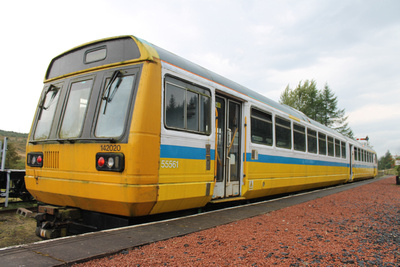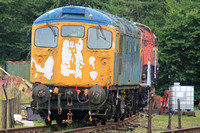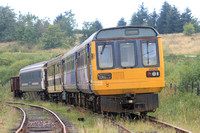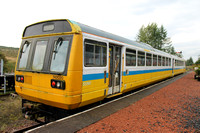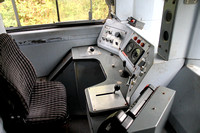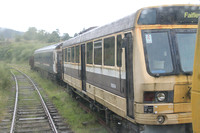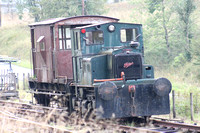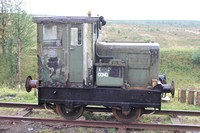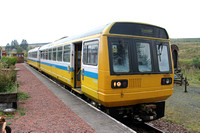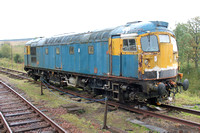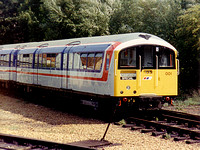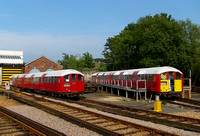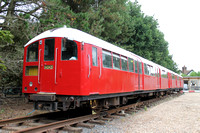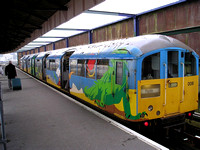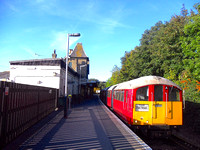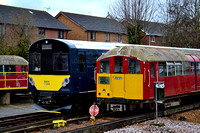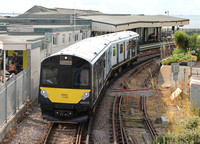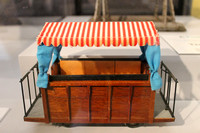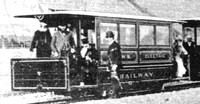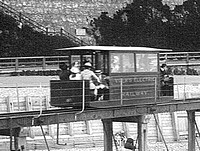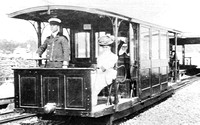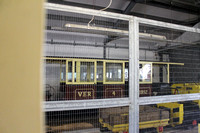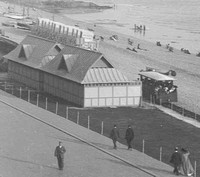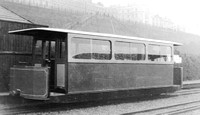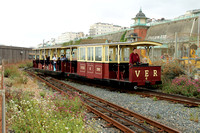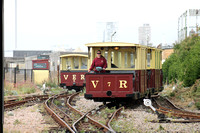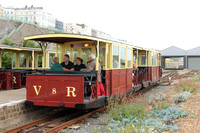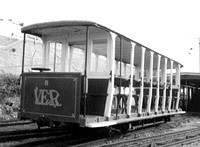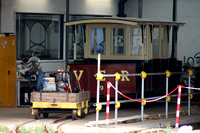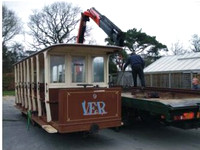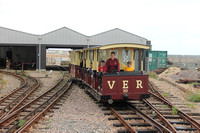Hi, Welcome to my blog. It will contain my latest sightings, links to my latest photos and info pages and any relevant news updates. It will be updated when possible.
New advert livery for Subway Cars 132 + 204+ 104 10.9.22
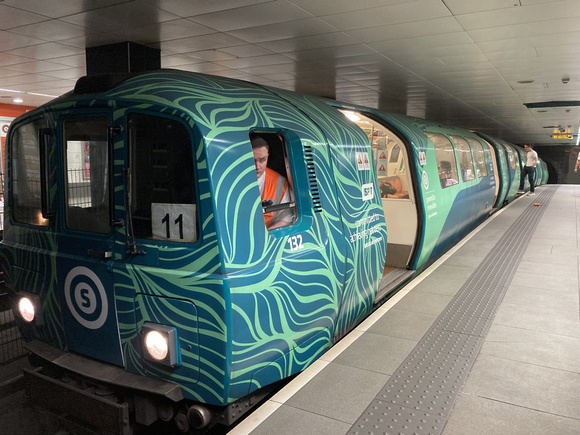
 Glasgow Subway's latest vynal wrap sees a 3 car set consisting of Metro Cammell Power Car 132, Barclay Trailer 204 and Metro Cammell Power Car 104 outshopped in a new design advertising SPT's commitment to achieving Net Zero.
Glasgow Subway's latest vynal wrap sees a 3 car set consisting of Metro Cammell Power Car 132, Barclay Trailer 204 and Metro Cammell Power Car 104 outshopped in a new design advertising SPT's commitment to achieving Net Zero.
the three car set are seen paused at St Enoch working diagram 11 on the Inner Circle on 10.9.22
614209 Demonstration run at Bo'ness 2.9.22
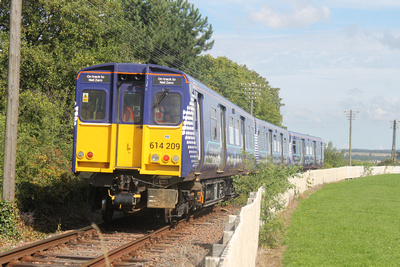
 Arcola Energy's Scottish Hydrogen Train, 614209 (former Scotrail Class 314 PEP unit 314209) was out today at Bo'ness operating demonstration runs for some invited guests during the day, between Bo'ness and Kinneil Halt. 614209 was run both on battery and on hydrogen mode on different runs with the mile long run out in each direction giving the invited guests the chance to sample both tractions from this bi-mode unit.
Arcola Energy's Scottish Hydrogen Train, 614209 (former Scotrail Class 314 PEP unit 314209) was out today at Bo'ness operating demonstration runs for some invited guests during the day, between Bo'ness and Kinneil Halt. 614209 was run both on battery and on hydrogen mode on different runs with the mile long run out in each direction giving the invited guests the chance to sample both tractions from this bi-mode unit.
It was great to finally see 209 out on the tracks and good to note that the distinctive compressor sounds remain from 209's days as a class 314 emu as does the sounds of the motors when accelerating in battery mode
I photoed 614209 at Bo'ness station (from the footbridge), Bo'ness foreshore and the area around Kinneil Halt, here are some of my efforts:
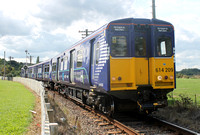 
|
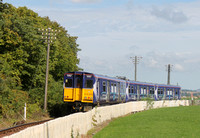 
|
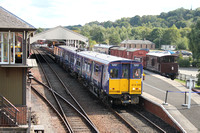 
|
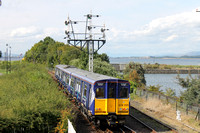 
|
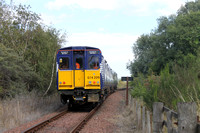 
|
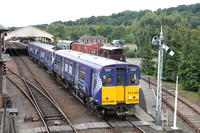 
|
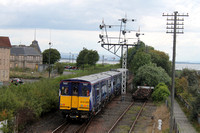 
|
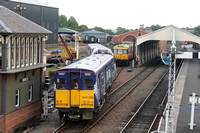 
|
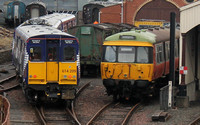 
|
Swift Express Freight's 321334 at Holytown 26.8.22
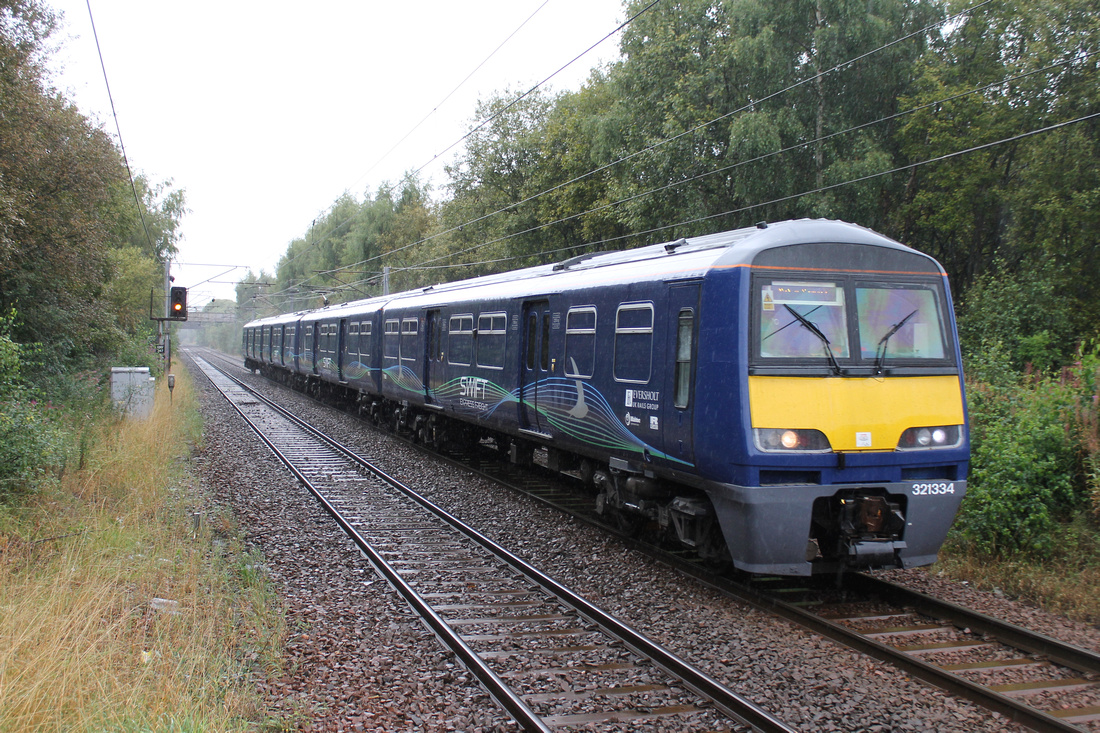

Returning from only its 2nd visit to Scotland, Swift Express Freight's 321334, which has been converted to carry up to 12 tonnes of parcels, approaches Holytown with 5Z84 Mossend - Doncaster ECS working 26.8.22
https://scottishtrains.zenfolio.com/p86324693/e3fc6e4eb
Visit to Isle of Wight 26.7.22
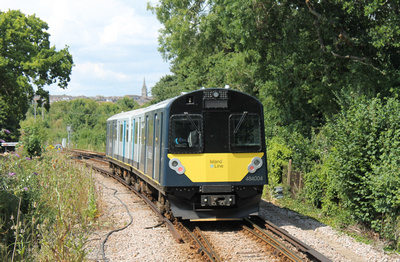
 I made my first ever trip to the Isle of Wight on 26th July. My day started with the 40 minute trip from my hotel at Eastleigh by train into Portsmouth Harbour, where I joined a long queue waiting for the Catamaran across to Ryde. I got a good spot up on the top deck to view the Harbour and the coastline of Portsmouth and Southsea on the short 20 minute crossing.
I made my first ever trip to the Isle of Wight on 26th July. My day started with the 40 minute trip from my hotel at Eastleigh by train into Portsmouth Harbour, where I joined a long queue waiting for the Catamaran across to Ryde. I got a good spot up on the top deck to view the Harbour and the coastline of Portsmouth and Southsea on the short 20 minute crossing.
On arrival at Ryde I headed into the Pier Head station where 484004 was waiting to form the 10.45 service to Shanklin. 484004 had just replaced 484002, which had failed on the previous service. It was a really smooth journey and despite the number of people who got off the ferry, I wouldn't have said it was packed.
The interior of 484004 was bright, modern looking, spacious and airy. I travelled to Lake, one stop short of the terminus, where I got off the train.
My reason for getting off one stop short of the terminus was that I was wanting to go and get some photos of 483004 at it's new home at Holliers Park in Arreton. The bus stop was a 5 minute walk from Lake station out on the main Ryde - Ventnor Road. From here I caught service 8, which runs half hourly to Amazon World. The journey took about 20 minutes and once off the bus was a 5 minute walk, turning left at the crossroads and walking about 1/4 mile. In Holliers Park, there is the House of Chilli, a craft centre and the Bus Stop Cafe, which is located in a converted bus.
483004 is currently in a fenced off section of former gravel car park, however the owner of the cafe kindly gave me permission to go in and have a look round and take some photos of the exterior. 483004 is looking excellent in its coat of London Transport Red with white roof. The visible side of the train has been fully painted, however the side that isn't visible is still mostly in the grey primer. The staff who are working on 483004 are really making an excellent job in restoring 483004, which is destined to become a cafe in the future. Before I left, I had a nice lunch at the Bus Stop Cafe, which I'd definately recommend and it cost less than £10.
I headed back towards the Island Line on bus service 8, however after mistakingly thinking that the service stopped at Sandown train station, where as it actually stopped on the front, I had a 15 minute walk up to the station, which meant that I'd just missed the train to Smallbrook Junction by 5 minutes and had almost an hours wait on the next one. Whilst I was waiting, 484003 passed through heading to Shankin on a driver training run and then returned a short time later heading in the direction of Ryde. As it was roasting by this point, I crossed over and decided to catch 484004 up to Shanklin, then from Shankin down to Smallbrook Junction.
At Smallbrook Junction, I got off and transferred over to the Isle of Wight Steam Railway. After a 10 minute wait, Hunslet Austerity 0-6-0 ST WD198 'Royal Engineer' arrived with a trainload of vintage Southern carriages for the journey to Wooton.
On the outbound journey, the train does not stop at Havenstreet so it is a straight end-to-end journey. After running round at Wooton, 198 led the train back to Havenstreet for a 10 minute stopover awaiting the passage of the other train on the line led by LMS Ivatt Class 2 41298.
Unfortunately due to missing the previous Island Line train and 198 being the final train of the day to Smallbrook Junction, I literally had 10 minutes to look round at Havenstreet, which included a very quick sprint up to 'Train Story' for a few shots of 483007. I just made it back to the platform in time for the train back to Smallbrook Junction.
By the time I reached there, the half hourly peak service had started, so I caught 484003, which was operating as the extra unit between Shanklin and Ryde Esplanade as far as Ryde St Johns, where I got a couple of photos of 484001 and 484002 stabled in the yard and 484003 on it's return journey to Shanklin.
I then caught 484004 from Ryde St Johns to Ryde Esplanade, where I got the classic shot of 004 heading along the pier. I then had a wander round the town before photoing the hovercrafts arriving, some buses and the 484003 arriving at Ryde Esplanade, then departing again via the tunnel. After grabbing a quick bite to eat, I walked along the Pier, catching some photos of 484004 heading to the Pier Head. I then ran up to the Pier Head for the Catamaran back to Portsmouth then back to the hotel.
Photos from my trip can be found at https://scottishtrains.zenfolio.com/p37224282
My History of the Island Line Blog can be found via the following links:
- Part 1: https://scottishtrains.zenfolio.com/blog/2022/8/island-line-isle-of-wight-26-7-22
- Part 2: https://scottishtrains.zenfolio.com/blog/2022/8/island-line-a-history-part-2-class-483s-and-484-1990---2022
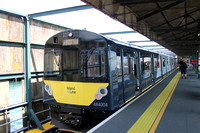 
|
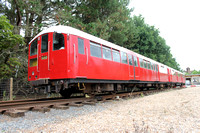 
|
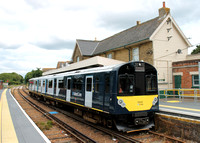 
|
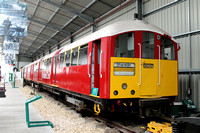 
|
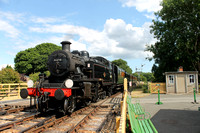 
|
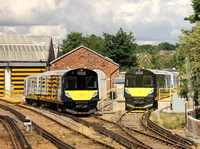 
|
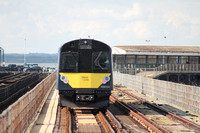 
|
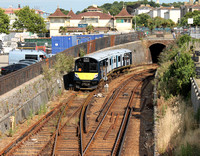 
|
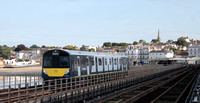 
|
Island Line: A History, Part 2: Class 483s and 484, 1990 - to date
Replacement of Standard Stock
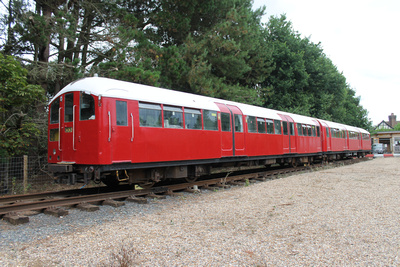
 British Rail originally started looking at replacing the Standard stock with the 1938 on the Isle of Wight back in the late 1970s, however they initially rejected the idea of using the 38 stock as the under floor mounted equipment would be vulnerable to waves, flooding and the salt air on Ryde Pier. However by 1988 when it became clear that the Standard stock would no longer be economically viable after 1990 and the offer was there to buy 38 stock, BR took up the offer. Initially they decided to buy 44 cars to allow trains to be made up of 4 cars consisting of a motor, two trailers and another motor. However, as Ryde St Johns depot was only capable of holding 2 cars in their maintenance sheds per road at a time and with storage space at a premium and BR being reluctant to spend money on expanding the depot facilities, it was decided to go with 2 car trains featuring two motor cars (A at the Ryde end and D at the Shanklin end). Electrical and braking equipment carried on the trailers being relocated to the motors.
British Rail originally started looking at replacing the Standard stock with the 1938 on the Isle of Wight back in the late 1970s, however they initially rejected the idea of using the 38 stock as the under floor mounted equipment would be vulnerable to waves, flooding and the salt air on Ryde Pier. However by 1988 when it became clear that the Standard stock would no longer be economically viable after 1990 and the offer was there to buy 38 stock, BR took up the offer. Initially they decided to buy 44 cars to allow trains to be made up of 4 cars consisting of a motor, two trailers and another motor. However, as Ryde St Johns depot was only capable of holding 2 cars in their maintenance sheds per road at a time and with storage space at a premium and BR being reluctant to spend money on expanding the depot facilities, it was decided to go with 2 car trains featuring two motor cars (A at the Ryde end and D at the Shanklin end). Electrical and braking equipment carried on the trailers being relocated to the motors.
Initially BR had planned a minimal refurbishment as they'd planned on the 38 stock being a stopgap that would be withdrawn and replaced in 1995 with 59/62 stock, which was due to be replaced on London Underground at that time, however BR carried out a far more extensive overhaul than expected and this meant a far longer service life was achieved in the end.
Initially 8x2 car trains were to be created and refurbishments and overhauls began in 1988 at Eastleigh and involved the conversion from London Underground's 4 rail operation to 3 rail, the fitting of flourescent lighting, allowing for Conductor / guard operation of the doors, fitting of passenger door controls, fitting of a PA system, reupholstering of seating and improvements to the interior decoration. On the exterior, Network South East livery would be applied.
Delivery and Unveiling
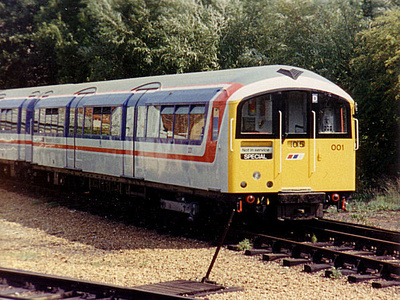
 The units were classified as the class 483s on TOPS and the first test run of one of the 2 car units was on 30th June 1989, between Eastleigh and Winchester. On 4th June 483001 was loaded in 2 parts onto low loaders at Fratton and taken to Gunship Wharf in Portsmouth for transfer onto the car ferry. 001 was then taken by road to the yard at Sandown where both halves were unloaded and coupled together and on 6th July 1989, 001 was hauled to Ryde St Johns depot by a train of standard stock and later that evening made its first test run on the island.
The units were classified as the class 483s on TOPS and the first test run of one of the 2 car units was on 30th June 1989, between Eastleigh and Winchester. On 4th June 483001 was loaded in 2 parts onto low loaders at Fratton and taken to Gunship Wharf in Portsmouth for transfer onto the car ferry. 001 was then taken by road to the yard at Sandown where both halves were unloaded and coupled together and on 6th July 1989, 001 was hauled to Ryde St Johns depot by a train of standard stock and later that evening made its first test run on the island.
On 13th July, 483001 was unveiled to the public on the shuttle platform at Ryde Pier Head, where a short ceremony took place before the train headed off to Brading with invited guests on board with a stop off at the site of the future Smallbrook Junction station to unveil a sign hearalding the future extension of the IOW Steam railway to Smallbrook Junction. 001 spent the remainder of the week working on the Pier shuttle and over the following weeks spent time on testing and driver training over the full line before being passed for passenger service.
It would be September before the next arrivals took place with 002 arriving on 26th September and 003 on the 27th. On 1st October 001 and 002 ran as a pair for test purposes with 001, 002 and 003 in that order running as a 6 car to see if it was possible to do so. 6 car running very rarely happened though with the exception of rescuing a failed train. 002 and 003 both entered service on 7th October 1989, joining 001 and the remaining standard cars in service.
The next class 483 to arrive on the island was 483007 on 12th March 1990. 007 was closely followed by 004 on 14th March and 005 on the 15th March. With the arrival of the class 483s, work was also going on to improve the depot facilities at Ryde St Johns with a raised pit road on one track and a full length pit on the other installed / improved and a carriage cleaning platform added in the depot yard. The new facilities were formally opened on 20th March 1990 by the Chairman of the British Rail Board, Sir Robert Reid.
During May 1990, the line was closed for 3 days to allow it to be reballasted and realigned slightly by use of a track machine to try and improve the ride qualities of the 483's which had been fine on the mainland but was decidedly bouncy on the island! 483004 debuted in service on 1st May 1990, with 005 and 007 debuting on 11th and 18th May 1990 respectively. 006 and 008 were delivered on 20th and 21st June, debuting in service on 29th June (008) and 13th July (006). Faults on cars 123 and 224 on sets 003 and 004 resulted in a hybrid unit 003 being formed from vehicles 223 and 124 from June 1990 - October 1991, when both units reverted to their correct formations.
On 20th July 1991, Smallbrook Junction became part of the Island Line when the extension of the steam railway opened to Smallbrook. The wooden halt acting as an interchange station is only open when the steam trains are running. 1991 also saw the end of regular running of the Pier Shuttle, with this being limited to only running ad hoc as and when required (and staff were available) in the following years.
Additional unit
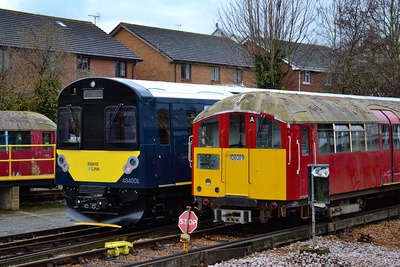
 It was decided to introduce an additional set for service from the original 8 planned, so 483009 was refurbished and sent over to IOW arriving on 9th April 1992 and entering service on 18th June 1992. As well as 009, an additional unit nominally numbered 483010 was sent across on 8th April 1992, however it had been stripped to a shell and was painted entirely in dark blue. Both cars were to be kept in case the body shells were required in the event of an accident to be refurbished to replace damaged vehicles. In 1993, the service was mostly cut to 2 trains per hour, however with the earlier singling of the track from Brading to Sandown, this caused the rather unpopular 20/40 minute split timetable. The full 20 minute timetable was restored at really busy times, with 1 train an hour throughout the winter.
It was decided to introduce an additional set for service from the original 8 planned, so 483009 was refurbished and sent over to IOW arriving on 9th April 1992 and entering service on 18th June 1992. As well as 009, an additional unit nominally numbered 483010 was sent across on 8th April 1992, however it had been stripped to a shell and was painted entirely in dark blue. Both cars were to be kept in case the body shells were required in the event of an accident to be refurbished to replace damaged vehicles. In 1993, the service was mostly cut to 2 trains per hour, however with the earlier singling of the track from Brading to Sandown, this caused the rather unpopular 20/40 minute split timetable. The full 20 minute timetable was restored at really busy times, with 1 train an hour throughout the winter.
Hybrids and Withdrawals
Heavy rain caused the flooding of Ryde St John's depot in early January 1994, meaning a temporary formation being made up from vehicles 129 (from 009) and 224 (from 004), this hybrid ran until 8th February 1994. On 10th February 1994, 483005 collided with the buffer stops at Ryde Pier Head, causing damage to the cab on vehicle 125. 483003 was out of service with defects, so the decision was taken to reform 003 with 123 from 003 and 225 from 005, with 125 and 223 becoming set 005 and being withdrawn, the first set to leave service.
Little over a year later in May 1995, 001 and 003 were reformed, with 121 and 225 becoming 001 and 123+221 became 483003 and was withdrawn from service. The number of servicable trains was reduced to 6 in 1996 with a further withdrawal and the final permanent reformation of a class 483 unit. 483001 was reformed with 121 and 222 (from 483002) and 483002 was reformed with 122 and 225 (from 001) with 001 being withdrawn from service. It was decided that 6 units would be enough to provide a service and have spares going forward.
In 1997 the Pier shuttle made a semi permanent return during the season, but only as and when there was enough staff / stock to cover it. The pier shuttle would continue to run on and off but on very rare occasions until the early 00s when the shuttle track was mothballed. In the early hours of March 1st 1998, the bodies of withdrawn cars 121, 125, 222 and 223 as well as the body shells from the nominally numbered but not used 483010 were lifted from the tracks and dumped in the car park at Ryde St John's depot awaiting scrapping 121, 125, 222 and 223 were scrapped on 24th April 2000, 483010 was scrapped by June 2005 . Vehicles 123 and 221 survived on track as a store for spare parts and as a possible spare unit if required but was scrapped in the mid - late 00s.
An interesting move occured at Christmas 1999 with a trio of class 483s working to Ryde Pier Head to get them away from Ryde St John's depot, which was flooded following heavy rain.
Dinsoaur Livery arrives
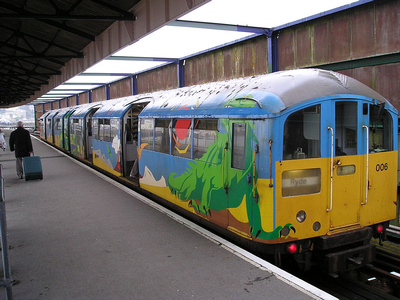
 During 2000, a new livery was forthcoming for the veteran class 483 fleet in the form of the rather bright but eyecatching Dinosaur livery! 483006 was first to receive the livery, being unveiled to the public and the press on 21st March 2000. 004 and 009 were repainted into Dinosaur livery around the same time with 008 and 002 following suit in the following months. The five units were named: 'Raptor' (002), T-Rex (004), Terry (006), Iggy (008) and Bronty (009). The repaint was part of a £1 million electrical and mechanical overhaul of the units. The sixth unit (007), was the final unit to remain in NSE livery, being withdrawn for repaint on 12th May 2000.
During 2000, a new livery was forthcoming for the veteran class 483 fleet in the form of the rather bright but eyecatching Dinosaur livery! 483006 was first to receive the livery, being unveiled to the public and the press on 21st March 2000. 004 and 009 were repainted into Dinosaur livery around the same time with 008 and 002 following suit in the following months. The five units were named: 'Raptor' (002), T-Rex (004), Terry (006), Iggy (008) and Bronty (009). The repaint was part of a £1 million electrical and mechanical overhaul of the units. The sixth unit (007), was the final unit to remain in NSE livery, being withdrawn for repaint on 12th May 2000.
Severe Floods and Major Repairs
007 had been repainted in London Transport livery and was nearing completion of it's electrical and mechanical overhaul when disaster struck. A severe flood on 9th/10th October flooded the depot and caused various degrees of damage to 002, 004, 006 and 007, with 007 receiving the worst damage of them all, indeed it was thought that the damage was so severe that the unit would have had to have been scrapped. 008 and 009 escaped damage and following track repairs to replace washed away ballast around Smallbrook Junction, were able to keep the service going. 004 received the least amount of damage and was able to return to service on 13th October. 006 returned to service on 13th December and 002 on 20th June 2001, both units requiring complete motor replacements.
007 took alot longer with many of its underfloor electrical components at the Ryde end having to be completely replaced. This was delayed by a major overhaul to 006 being required and the parts being diverted to it. A second serious flood caused more damage then when 007 was moved out into the yard to allow others into the shed for maintenance, it was attacked by Graffitti 'artists'. By the end of 2002, the damaged components were refitted to 007, the unit was repainted and finished off in authentic London Transport style branding and numerals, with 007's original LT numbers being displayed on the bodysides. Following a relaunch back into service on 24th March 2003, 007 resumed normal passenger duties on 27th March 2003. A second unit, 483009 was repainted into LT livery but minus the LT branding in October 2003, to allow a matching set to run when in 4 car formation.
New Franchise - Retro livery
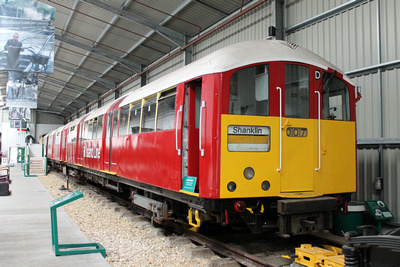
 483002 was stored out of use in the yard at Ryde St Johns from sometime in 2004. In 2007, came a new franchise owner in the form of Stagecoach, who decided to repaint the entire fleet in the heritage London Transport red livery. The final by this time rather tired looking Dinosaur liveried train, 483006 being repainted in Winter 2008 / 09. Even the withdrawn 483002 was treated to the new livery!
483002 was stored out of use in the yard at Ryde St Johns from sometime in 2004. In 2007, came a new franchise owner in the form of Stagecoach, who decided to repaint the entire fleet in the heritage London Transport red livery. The final by this time rather tired looking Dinosaur liveried train, 483006 being repainted in Winter 2008 / 09. Even the withdrawn 483002 was treated to the new livery!
Final years of the class 483
In 2016, 483009 was withdrawn from passenger service, being demoted to use as the Ryde depot shunter, with 007 being withdrawn for a 2 1/2 year long overhaul in 2017. This would leave 004, 006 and 008 to operate the service. By this time, services were no longer being operated in 4 car formation. The fleet was further reduced when 004 was withdrawn in 2019 and was used to provide spare parts to keep 006 and 008 going.
On 13th September 2019, South Western Railway announced that due to a 'safety issue' that only one unit was able to run, meaning that it was only possible to run an hourly service. The hourly service remained for 5 weeks, when a 2 car service was able to resume. 3 days into the hourly service commencing, South Western Railway announced that five ex District Line 'D' Stock trains in 2 car formation (the class 484s) would be replacing the class 483s. Meanwhile issues with the class 483s continued into November with several days of disruption and reduced timetables.
The last year
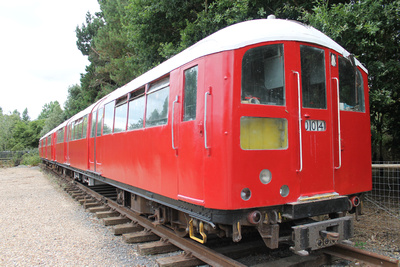
 It was announced that the final day of operation for the Class 483s would be Sunday 3rd January 2021 as the line needed to close to allow for upgrade works prior to the class 484s entering service. For most of the final year of the class 483s, Covid 19 led to an hourly service with only one train being used, equaling the burden between sets 006 and 008 for the majority of the year, however for a spell in November 2020 there were no trains available for service at all. 483008 was withdrawn from service on 4th December 2020 and it was expected that 006 would soldier on for the last month alone, however 483007's protracted overhaul was completed in mid December allowing the burden to be shared. On 10th November, the first class 484, 484001 arrived on the island and having been offloaded at Sandown, was driven slowly under it's own power to Ryde St Johns Depot. 484001 was seen out on occasional test runs during December.
It was announced that the final day of operation for the Class 483s would be Sunday 3rd January 2021 as the line needed to close to allow for upgrade works prior to the class 484s entering service. For most of the final year of the class 483s, Covid 19 led to an hourly service with only one train being used, equaling the burden between sets 006 and 008 for the majority of the year, however for a spell in November 2020 there were no trains available for service at all. 483008 was withdrawn from service on 4th December 2020 and it was expected that 006 would soldier on for the last month alone, however 483007's protracted overhaul was completed in mid December allowing the burden to be shared. On 10th November, the first class 484, 484001 arrived on the island and having been offloaded at Sandown, was driven slowly under it's own power to Ryde St Johns Depot. 484001 was seen out on occasional test runs during December.
On 3rd January 2021, the final day of service for the class 483s, 007 started the day with the hourly service and was replaced at lunchtime by 006, which finished the day and brought down the curtain on 31 years of service for the class 483. The final 6 units are all still in existance in various states of repair: 483002 is currently stored in the yard of Railway Support Services in Wishaw (England), 483004 is currently being converted to an on site cafe at Holliers Park, Arreton on the Isle of Wight, 483006 and 483008 are currently preserved by the London Transport Traction Group at the Llanelli and Mynydd Mawr Railway in Wales and will hopefully both be runners again one day, 483007 is currently on display at the 'Train Story' shed on the Isle of Wight Railway and it is hoped to be a runner again in the future. 483009 is in 2 locations with 129 having been restored by a private buyer at the East Somerset Railway and 229 remaining stored in the yard of Reid Freight in Longton.
Line upgrade and introduction of the class 484
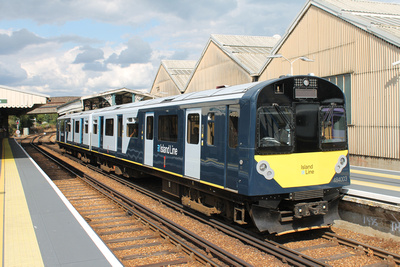
 After 483006 returned to depot for the last time and the power was switched off, work quickly commenced on the upgrade of the line with the platforms at all stations needing to be raised in line with the increased line of the 'new' former sub surface stock which were taller than the former deep tube stock that they replaced. Track replacement at some parts of the line was also needed as was work to reinstate the disused 2nd platform at Brading with a passing loop being built. The work was met with delays and with late delivery of the trains and software issues with the trains, the line did not reopen until 1st November 2021, some 8 months after it was due to reopen. 484001-484004 were available for service from reopening with 484005 not being delivered until February 2022 and still not having been handed over to South Western Railway. Trains currently run hourly from Ryde Pier Head to Shanklin, with a second unit entering sevice in the morning and afternoon peaks and operating between Ryde Esplanade and Shankin.
After 483006 returned to depot for the last time and the power was switched off, work quickly commenced on the upgrade of the line with the platforms at all stations needing to be raised in line with the increased line of the 'new' former sub surface stock which were taller than the former deep tube stock that they replaced. Track replacement at some parts of the line was also needed as was work to reinstate the disused 2nd platform at Brading with a passing loop being built. The work was met with delays and with late delivery of the trains and software issues with the trains, the line did not reopen until 1st November 2021, some 8 months after it was due to reopen. 484001-484004 were available for service from reopening with 484005 not being delivered until February 2022 and still not having been handed over to South Western Railway. Trains currently run hourly from Ryde Pier Head to Shanklin, with a second unit entering sevice in the morning and afternoon peaks and operating between Ryde Esplanade and Shankin.
Photos from Wikimedia commons:
- 001: https://commons.wikimedia.org/wiki/File:483_001_at_St_John%27s_Road,_1989_-_geograph.org.uk_-_790855.jpg
- 002: https://commons.wikimedia.org/wiki/File:483002_483007_Ryde_Electric_Depot.JPG
- 006: https://commons.wikimedia.org/wiki/File:Island_Line_train_-_geograph.org.uk_-_836245.jpg
- 008: https://commons.wikimedia.org/wiki/File:483008_Shanklin.jpg
- 009: https://commons.wikimedia.org/wiki/File:484001_and_483009_at_Ryde_Traincare.jpg
- Remainder are my own photgraphs, more of which can be found at: https://scottishtrains.zenfolio.com/p37224282
Island Line: Isle of Wight A History Part 1 - Standard Stock 1967 - 1991
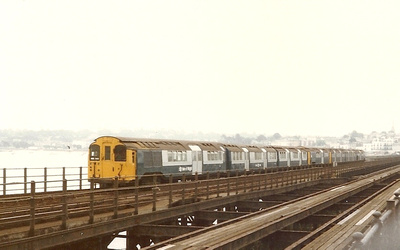
 Having visited the Isle of Wight on 26th July, I decided I would write a blog post about my visit, however I wanted to explain a bit of the history of the Island Line first before I write about my visit. The history will be over 2 posts, with this post being mainly about the Standard tube stock and the line from 1967 onwards till 1990/91 and the second part will be about the 1938 stock and the current ex District Line stock, with my trip report being in a third post.
Having visited the Isle of Wight on 26th July, I decided I would write a blog post about my visit, however I wanted to explain a bit of the history of the Island Line first before I write about my visit. The history will be over 2 posts, with this post being mainly about the Standard tube stock and the line from 1967 onwards till 1990/91 and the second part will be about the 1938 stock and the current ex District Line stock, with my trip report being in a third post.
Please note: the photo on this page is from Wikimedia Commons and is of a 3 Tis + 4 Vec (class 486+485) 7 car formation working on the Pier Head - Esplanade Shuttle in 1984. The original photo can be found at: https://commons.wikimedia.org/wiki/File:BR_Class_485_train_on_Ryde_Pier_IoW.jpg
Introduction
The Isle of Wight Railway history stretches back as far as 1862 with the building of a line from Cowes to Newport. Ryde St Johns Road - Shanklin followed in 1864 with a later extension from Shanklin - Ventnor following in 1866. Smallbrook Junction - Newport in 1875 and Ryde St Johns Road - Ryde Pier Head in 1880 also followed. Other branches from Merstone - Ventnor West, Freshwater - Newport, Sandown - Newport and Brading - Bembridge ensured that by 1900, the Isle of Wight was served by 55 1/2 miles of railways.
By 1956 low patronage of many of the branch lines, particularly off season led to closure of the lines from Cowes to Newport, Merstone - Ventnor West, Sandown - Newport, Freshwater - Newport and Brading - Bembridge leaving only the Ryde Pier Head - Ventnor and Newport lines open. Into the 1960s and the Beeching Report recommended the full closure of the remaining lines on the island other than the short but busy stretch between Ryde Pier Head and Ryde St John's Road. A local hard fought campaign for the retention of the Ryde - Ventnor line eventually managed to save the 8 1/2 mile line from Ryde - Shanklin, with the closure of the Shanklin - Ventnor stretch and the Smallbrook Junction - Newport branch of the line in 1966.
Rationalisation and Introduction of the Standard Stock
With the line saved, British Railways announced a modernisation and track rationalisation programme for the 8 1/2 mile stretch of line so next came the challenge of replacing the elderly Adams Class 02 steam locos (with an average age of 74) and wooden bodied, non corridor, 4 wheeled Southern Railways rolling stock with their unique loading gauge. The rolling stock was narrower and shorter that of the trains on the mainland, to allow them to pass under the bridges on the line and the Ryde Tunnel. The option chosen was to approach London Underground to buy some of their recently withdrawn tube stock. It was the right profile for the tunnel and the bridges so would be a suitable option! By chance, London Underground was withdrawing some of it's pre 1938 stock (built between 1923 and 1934) so by 1965 and with the approval of BR to begin a programme of electrification of the Ryde to Shanklin stretch, 46 pre 1938 stock vehicles were purchased.
This was soon reduced to 43 cars to save money, with 19 Driving Motors (numbered S1S-S11S, S13S, S15S, S17S, S19S-S23S and S25S), 6 control trailers (numbered S26S, S28S, S30S, S32S, S34S, S36S), 4 ex control trailers (Numbered S27S, S29S, S31S, S33S) and 14 trailers (numbered S41S-S49S and S92S-S96S) purchased. Initially they were marshalled into 6x 4 cars ('4 VEC' or class 485 numbered 041-046) and 6x3 cars ('3TIS' Class 486 031-036) with one spare motor (S10S). The formation was as follows: 4 car: Motor - Trailer - Trailer - Motor 3 car: Control Trailer - Trailer - Motor. The initial plan was for 2 x 4 car sets to be used for winter traffic and as many as 6 x 7 car (4&3 car combined) on Summer Saturdays. Each set had an 'A' motor (or control trailer) at the Ryde Pier Head end and a 'D' motor at the Shanklin end as A and D motors had different equipment underneath them, it was not possible to have 2 A or D cars as the Driving Motors in the one set.
| 3TIS | Control Trailer (A) | Trailer | Driving Motor(D) | |
| 031 | 26 | 47 | 1 | |
| 032 | 28 | 92 | 3 | |
| 033 | 30 | 93 | 5 | |
| 034 | 32 | 94 | 7 | |
| 035 | 34 | 95 | 9 | |
| 036 | 36 | 96 | 11 | |
| 4VEC | Driving Motor(A) | Trailer | Trailer | Driving Motor(D) |
| 041 | 20 | 27 | 41 | 13 |
| 042 | 22 | 29 | 42 | 15 |
| 043 | 2 | 31 | 43 | 19 |
| 044 | 4 | 33 | 44 | 21 |
| 045 | 6 | 48 | 45 | 23 |
| 046 | 8 | 49 | 46 | 25 |
| Spare | 10 |
The steam era on the Isle of Wight ended on 31st December 1966 as work to complete the electrification and cut the four platform tracks at the Pier head down to two continued whilst platforms at the other stations were lowered to allow the pre 38 standard stock to use them. 11 weeks after the steam era finished, the electric era began on Monday 20th March 1967 with trains operated by 4 VEC 041 and 3 TIS 031 (with the spare Motor car S10S attached to make it up to 4 cars). The Sandown school special was operated by a 7 car set made up of 032 and 044.
Early years of the Tube stock services
By Autumn 1967, a shunting accident caused damage to Motor Car S15S which led to the car being scrapped in 1969 and a replacement was sought in the form of another car that had been withdrawn by London Underground. It was repainted at Stewarts Lane and transferred by ferry over to the Isle of Wight, arriving during 1971. In 1969, the Pier tramway, which ran on a seperate pier alongside the line closed and was replaced by a 7 car set shuttling between the Pier Head and Esplanade stations before running ECS to Ryde St Johns. As a 7 car train was required for the shuttle, the timetable was reduced south of the Esplanade to 4 trains per hour, which meant that the up platform at Shanklin was rarely used in service and by 1971 the platform buildings were demolished and the subway between platforms was filled in.
By 1973 the scissors crossing for access to Pier Head Station was worn out and in need of replacement also the Pier Head Signal Box which was its self in need of replacement. Rather than replace it with a new crossover, plain track was fitted to both tracks and a trailing crossover south of Esplanade station on the ramp to the tunnel was installed, rendering the Pier Head signal box redundant at the same time and allowing its closure and demolition. This led to the southbound track becoming a dedicated bi directional shuttle track for the pier shuttle and removed dead mileage of having to go to St Johns to reverse. The main service used the former northbound track, which also became bi directional as the same time.
Also during 1973, the number of trains available for use decreased following a shunting accident between 4Vec 045 and 3Tis 035, which resulted in the withdrawal and scrapping of 3 vehicles (Driving Motor S23S and Trailers S45S and S48S from 045) and the reformation of the remaining four vehicles into a new formation of 4Vec 045. The fleet was further reduced during 1975 when S25S, the Shanklin end driving Motor from 4VEC 046 was severely damaged and with no spare motor vehicle suitable for working on the Shanklin end available, 046 was disbanded with the remaining vehicles being kept as spares.
By 1979, the service had reduced to 3 trains per hour during the summer and this allowed for further rationalisation at Shanklin with the removal of the headshunt (remains of the former line to Ventnor) beyond the station and the track in the up platform. This also meant that only 1 train could be south of Sandown at a time.
Rundown and Replacement
The pool of available vehicles was further reduced with the disbanding of set 033 in 1982. 033's driving motor replaced that of set 043 with vehicle S30, 033's control trailer being removed from the track at St Johns for use as a store, while S19 from 043 was moved to Sandown to the PW yard there also as a stores vehicle.
Attention started to turn to the replacement of the Standard Stock, with consideration being given to the transfer and use of the Merseyrail class 503s, which were about to be withdrawn and replaced by class 508s and the other option of 1938 stock from London Underground, which was about to be partially withdrawn from the Underground also being considered and initially rejected due to the electrical equipment being located under the floor and this was considered a risk especially with the line travelling along the pier. Some 7 years later, the 1938 stock would come to the Island Line and would replace the Standard stock.
With the replacement of the Standard stock having been rejected, the remaining fleet were treated to an £80,000 interior and exterior refresh, with an interior repaint, new lino and new moquette fitted in the interior and BR Blue / Grey livery painted on the exterior. A further four vehicles were withdrawn in 1985 (Driving motors S13 and S21, Control Trailer S36 and Trailer 96) leaving 29 vehicles for service, these being reformed into 5 x 5 car units (5 Vec) and 2 x 2 car units (2 TIS) and from January 1987, the remaining vehicles began to be repainted into Network South East livery. Also in 1987, the first new station on the line in many decades was opened in the form of the single platformed station at Lake, between Sandown and Shankin, which opened on 11th May 1987. Lake station could only handle a maximum of 5 coach lengths of standard stock, which effectively put an end to the use of 7 car trains.
In August 1988, it was confirmed that 'new' trains were on the way to the Island in the form of then 48 year old 1940 built '38 stock from London Underground, with 8 x 2 carriage trains expected to be delivered and at that point were expected to be in service by May 1989. Network South East were reportedly spending £900,000 on a full refurbishment of the 'new' trains.
Over the weekend of 29th-30th October 1988, the track between Brading and Sandown was reduced to single track, this had the added effect of making the signal boxes at Brading and Sandown redundant, with all signalling concentrated on the one remaining box at Ryde St Johns. Brading signal box became a small museum in later years whilst Sandown box was demolished a year later in 1989.
The singling of the track from Brading (which was reduced to one platform, with the former island platform on the down side becoming redunant) through to just outside of Sandown station was fine for the then 20 minute service in operation using 3 trains, however when the service was further reduced to 2 trains per hour, the timetable became a lop sided affair with a 20/40 minute split.
The first class 483, 483001 was delivered during 1989 and made its offical debut on 15th July 1989 taking invited guests from the Pier Head to Sandown with a stop off at Smallbrook Junction to reveal a sign announcing the extension of the Isle of Wight Steam Railway from Havenstreet through to Smallbrook Junction, where a new halt would be built linking the 2 lines. 483001 would spend time during the summer working on the Esplanade - Pier Head shuttle. Over the course of 1989, the remaining Standard stock reverted to 4 car formations, eventually being reduced to 17 vehicles. By August 1990, there were sufficient class 483s in service for the Standard stock to be reduced to 7 vehicles in service, a 4 car set made up of 2, 26, 49 and 7 and a 3 car set made up of 28, 31 and 5. However by the following month only the 3 car set remained available for service, mainly for de-icing purposes, but also occasionally in service, with the last official recorded passenger service use being on 12th January 1991, with the final de-icing run taking place on 17th January 1991, though unofficially, the train carried passengers from the Esplanade to Pier Head to connect with a catamaran service to Portsmouth.
Most of the cars once withdrawn, were scrapped either on the island or the mainland, however 5 of them were returned to London Transport as part of a Vintage Train project with Motor cars S2S and S7S and Trailers S49S, S27S and S44S chosen. S27S and S44S were repainted into London Transport colours at Ryde St Johns however, the project never really took off and some of the cars remain stored or have been scrapped.
| Number | Type | LT Number | In Service (IOW) | Withdrawn | Disposal |
| 1 | 'D' Driving Motor | 3703 | 20.3.67 | 6.6.90 | Scrapped 7.1.93 |
| 2 | 'A' Driving Motor | 3706 | 20.3.67 | 7.9.90 | LT Heritage Train Project |
| 3 | 'D' Driving Motor | 3251 | 20.3.67 | 1989 | Scrapped 4.10.90 |
| 4 | 'A' Driving Motor | 3702 | 20.3.67 | 28.9.89 | Scrapped 4.10.90 |
| 5 | 'D' Driving Motor | 3185 | 20.5.67 | 13.5.91 | Scrapped 23.4.94 |
| 6 | 'A' Driving Motor | 3084 | 15.5.67 | 1.2.90 | Scrapped 1991 |
| 7 | 'D' Driving Motor | 3209 | 26.4.67 | 7.9.90 | LT Heritage Train Project |
| 8 | 'A' Driving Motor | 3074 | 20.3.67 | 6.6.90 | Scrapped 8.1.93 |
| 9 | 'D' Driving Motor | 3223 | 26.4.67 | 3.10.89 | Scrapped 1991 |
| 10 | 'A' Driving Motor | 3696 | 20.3.67 | 6.6.90 | Scrapped 5.1.93 |
| 11 | 'D' Driving Motor | 3705 | 22.3.67 | 18.1.90 | Scarpped 15.1.93 |
| 13 | 'D' Driving Motor | 3141 | 1967 | 03.85 | Scrapped 1987 |
| 15 (i) | 'D' Driving Motor | 3253 | 20.3.67 | 7.10.67 | Scrapped 10.5.69 |
| 15 (ii) | 'D' Driving Motor | 3273 | 1971 | 11.4.88 | Scrapped 8.5.89 |
| 19 | 'D' Driving Motor | 3045 | 20.5.67 | 12.82 | Scrapped 21.4.89 |
| 20 | 'A' Driving Motor | 3308 | 1967 | 11.4.88 | Scrapped 8.5.89 |
| 21 | 'D' Driving Motor | 3041 | 20.3.67 | 3.85 | Scrapped 6.87 |
| 22 | 'A' Driving Motor | 3010 | 20.3.67 | 14.11.86 | Scrapped 16.5.89 |
| 23 | 'D' Driving Motor | 3315 | 15.5.67 | 10.9.73 | Scrapped 4.5.74 |
| 25 | 'D' Driving Motor | 3313 | 22.3.67 | 8.9.75 | Scrapped 10.82 |
| 26 | 'A' Control Trailer | 5294 | 20.3.67 | 7.9.90 | Scrapped 18.4.94 |
| 27 | Ex Control Trailer | 5279 | 1967 | 18.1.90 | LT Heritage Train Project |
| 28 | 'A' Control Trailer | 5304 | 20.3.67 | 13.5.91 | Scrapped 14.4.94 |
| 29 | Ex Control Trailer | 5293 | 20.3.67 | 25.9.89 | Scrapped 16.10.90 |
| 30 | 'A' Control Trailer | 5312 | 20.5.67 | 12.82 | Scrapped 7.87 |
| 31 | Ex Control Trailer | 5283 | 20.5.67 | 13.5.91 | Scrapped 16.4.94 |
| 32 | 'A' Control Trailer | 5290 | 26.4.67 | 4.9.89 | Scrapped 15.10.90 |
| 33 | Ex Control Trailer | 5291 | 22.3.67 | 20.9.89 | Scrapped 13.10.90 |
| 34 | 'A' Control Trailer | 5302 | 26.4.67 | 6.6.90 | Scrapped 20.10.90 |
| 36 | 'A' Control Trailer | 5350 | 22.3.67 | 3.85 | Scrapped 6.87 |
| 41 | Trailer | 7286 | 1967 | 12.9.86 | Scrapped 8.5.89 |
| 42 | Trailer | 7280 | 20.3.67 | 27.11.86 | Scrapped 16.5.89 |
| 43 | Trailer | 7275 | 20.5.67 | 30.9.88 | Scrapped 25.10.90 |
| 44 | Trailer | 7281 | 20.3.67 | 3.2.90 | LT Heritage Train Project |
| 45 | Trailer | 7293 | 15.5.67 | 10.9.73 | Scrapped 4.5.74 |
| 46 | Trailer | 7283 | 22.3.67 | 7.9.90 | Scrapped 16.5.89 |
| 47 | Trailer | 7279 | 20.3.67 | 11.87 | Scrapped 25.10.90 |
| 48 | Trailer | 7298 | 15.5.67 | 10.9.73 | Scrapped 5.4.74 |
| 49 | Trailer | 7296 | 22.3.67 | 7.9.90 | LT Heritage Train Project |
| 92 | Trailer | 7285 | 20.3.67 | 4.10.88 | Scrapped 14.10.90 |
| 93 | Trailer | 7282 | 20.5.67 | 18.1.90 | Scrapped 20.10.90 |
| 94 | Trailer | 7287 | 26.4.67 | 3.10.89 | Scrapped 17.10.90 |
| 95 | Trailer | 7292 | 26.4.67 | 5.3.90 | Scrapped 23.10.90 |
| 96 | Trailer | 7290 | 22.3.67 | 3.85 | Scrapped 6.87 |
Volks Electric Railway 25.7.22
I visited the Volks Electric Railway for the very first time on Monday 25th July. This short 1 mile line has many years of interesting history and is the oldest remaining electric railway in the world.
I will describe my visit later in the blog but first some of the history of the line:
The Founder
Magnus Volk, the son of a German Clockmaker was born in Brighton on 19th October 1851, he was known as an inventor and pioneer in the Brighton area with some of his projects including inventing a fire alarm system, having the first electrically lit house in Brighton, an early attempt at telecommunications with a neighbouring house and being a contract to electrically light Brighton's Royal Pavilion.
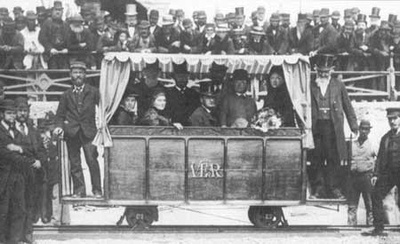
 Demonstration Line
Demonstration Line
His successful experimentations with electricity led to his next, most successful and enduring project: the Volk's Electric Railway! After gaining permission from Brighton Corporation for a 1/4 mile long 2 foot gauge line running from the Palace Pier to the Chain Pier, work quickly progressed and before long, the line was ready! The line was powered by a 2 horse power gas engine, which drove a Siemens D5 50 volt DC Generator. The original car, built by William Pollard in 1883, seated 10 passengers and resembled a coal wagon with drivers platforms, awning over the passenger area as well as curtains for the side. The 1 1/2 horse power motor allowed for a top speed of 6 mph. Magnus Volk unveiled this creation to a very interested public at 12 noon on 6th August 1883.
Early years
With the initial line being a success, Volk applied for permission to extend the line Westwards to the town boundary, unfortunately permission wasn't granted, however he did get permission to extend the line eastwards to the Banjo Groyne and rented out the 'Arch' at Paston Place, which was to become the VER Headquarters (remains so to this day) and the line's workshops. A line was built across the promenade to reach the Arch Workshops, which also housed the line's new upgraded power generator.
Over winter 1883/84 the line was relayed to the wider gauge of 2 ft 8 1/2 inches and the new stretch required some structures to be built in the form of timber trestles to bridge the gaps in the shingle and the section at the Chain Pier made on a gradient to allow the line to pass underneath the pier Initally the track was of the 2 rail variety with one rail being the live feed and the other was the return, however this proved unreliable especially in stormy conditions and the system was switched to run off the third rail in 1886. A 2 platform station was opened at the Banjo Groyne with a halt opening halfway along the line, where a passing loop was also built. Palace Pier station was also a 2 platform station. The line now had a total length of 1400 yards.
The original Pollard built car was unable to be converted to the new wider gauge so it was scrapped and replaced by two new cars (numbered 1 & 2). The new cars had a central passenger saloon with seating for 18 passengers on long bench seats with 12 passengers able to be seated outside on the open platforms. Similar to most trams of the time, the passenger saloon was accessed from the centre of the open platforms, which also featured the driver's controls.
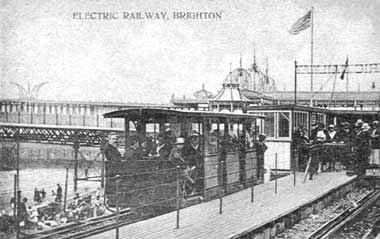
 The new extended line opened on 4th April 1884 and only Car 1 was in use at this time as Car 2 did not arrive till Summer 1885. With the installation of the 3rd rail in 1886, the line was also raised and placed onto a wooden viaduct. With the arrival of Car 2, the service level was increased to a car every 5 minutes. The line grew in popularity with it more cars with bigger capacity were required so in 1892, Cars 3 and 4 were built by the VER and initially entered service as open sided cars seating 40 people, however it was soon realised that the cars were unsuitable for winter operation as their canvas blinds were of no real use against the harsh winter weather and they were converted to semi-open trams that winter, with a further refurbishment in 1901 bringing them to the same shape / style that they are in today. A further car was built in 1896, car 5, which was built by the VER to a similar style as that of car 2, seating 30 passengers but with one difference, the window panes were detatchable, making suitable as a summer and a winter car where required.
The new extended line opened on 4th April 1884 and only Car 1 was in use at this time as Car 2 did not arrive till Summer 1885. With the installation of the 3rd rail in 1886, the line was also raised and placed onto a wooden viaduct. With the arrival of Car 2, the service level was increased to a car every 5 minutes. The line grew in popularity with it more cars with bigger capacity were required so in 1892, Cars 3 and 4 were built by the VER and initially entered service as open sided cars seating 40 people, however it was soon realised that the cars were unsuitable for winter operation as their canvas blinds were of no real use against the harsh winter weather and they were converted to semi-open trams that winter, with a further refurbishment in 1901 bringing them to the same shape / style that they are in today. A further car was built in 1896, car 5, which was built by the VER to a similar style as that of car 2, seating 30 passengers but with one difference, the window panes were detatchable, making suitable as a summer and a winter car where required.
The Daddy Long Legs
Magnus Volks wanted to extend the line eastwards towards Rottingdean, however a steep climb to the cliff top or the possibility of building a viaduct over unstable ground ruled this out, so ever being the inventor, he came up with an ingenious invention, 'The Daddy Long Legs'. The Daddy Long Legs was basically a cross between a tram and a boat with large legs reaching the seabed where rails were installed! There was an overhead wire installed with trolley pole giving the tram element. The rails were laid from Paston Place to Rottingdean through the water but reasonably close to the shore. Opening in 1896, the Daddy Long Legs proved popular, however the experiment almost ended in disaster as a massive storm shortly after opening caused serious damage including the vehicle ending up on its side. Volks percivered and repairs were completed, allowing the line to reopen in 1897.
Things wouldn't run smoothly for long as damage to the trackbed closed the line for 2 months in 1900, followed by the new that the line would have to be diverted deeper into the sea to make room for new sea defences between Paston Place and Black Rock essentially ended this unique railway, however the end of the Daddy Long Legs had good effects on the future of the Volks Electric Railway .....
Extension
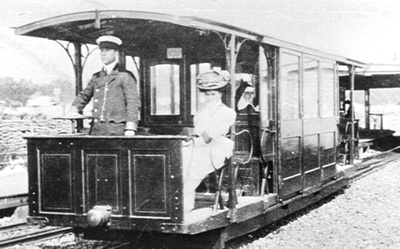
 Following the demise of the Daddy Long Legs, the Volks Electric Railway was extended further eastwards to Black Rock in 1901, thus allowing the creation of an enduring feature of the line, 'The Tunnel'. The Tunnel was a part of the original car sheds but converted to a through track so you were actually passing through the sheds! Heading eastward from the sheds at Paston Place, the line headed onto a steel viaduct at the Banjo Groyne then along wooden viaducts along the beach to a new 2 platform terminus at Black Rock. Volk intended on trying to extend to Rottendean, but there wasn't the funds to extend further. The extension to Black Rock required further cars, with Volk estimating that 7 cars would be required to operate the service so the railway built an additional cars numbered 6,7 and 8, giving an extra car for extra flexibility / cover for maintenance. 6,7 & 8 were all 40 seater Semi Open cars and had a similar look to cars 3 &4.
Following the demise of the Daddy Long Legs, the Volks Electric Railway was extended further eastwards to Black Rock in 1901, thus allowing the creation of an enduring feature of the line, 'The Tunnel'. The Tunnel was a part of the original car sheds but converted to a through track so you were actually passing through the sheds! Heading eastward from the sheds at Paston Place, the line headed onto a steel viaduct at the Banjo Groyne then along wooden viaducts along the beach to a new 2 platform terminus at Black Rock. Volk intended on trying to extend to Rottendean, but there wasn't the funds to extend further. The extension to Black Rock required further cars, with Volk estimating that 7 cars would be required to operate the service so the railway built an additional cars numbered 6,7 and 8, giving an extra car for extra flexibility / cover for maintenance. 6,7 & 8 were all 40 seater Semi Open cars and had a similar look to cars 3 &4.
In 1926, a further two cars built by the VER joined the fleet in the form of open cars 9 and 10, both of which had seating for 40 passengers.
Cut Backs
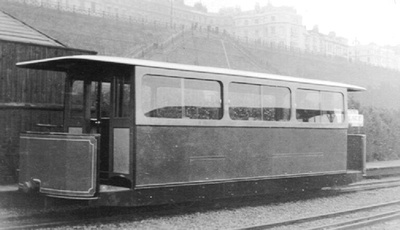
 The development of Maderia Drive in 1930, meant that the line was cut back at the west end from Palace Pier to opposite the Aquarium, with the station being renamed 'Aquarium' and being built with a 2 track layout. Volk decided at a winter car was needed and with the original Car 5 needing a rebuild, it was decided to scrap it and built a new one. In a complete change from the traditional wooden built cars, the new number 5, which had it's body built by G Kelsey Coachbuilders of Hove, had its bodywork completely fabricated from steel, with a wooden roof and wooden floor. No 5 had no outside passenger accomodation, all were seated indoors, in 2 long bench seats along the body sides, covered in blue leather and seating 24 passengers. The bodysides had 3 large sliding windows and the outside of the car was painted in a rather striking sky blue and primrose yellow colour scheme.
The development of Maderia Drive in 1930, meant that the line was cut back at the west end from Palace Pier to opposite the Aquarium, with the station being renamed 'Aquarium' and being built with a 2 track layout. Volk decided at a winter car was needed and with the original Car 5 needing a rebuild, it was decided to scrap it and built a new one. In a complete change from the traditional wooden built cars, the new number 5, which had it's body built by G Kelsey Coachbuilders of Hove, had its bodywork completely fabricated from steel, with a wooden roof and wooden floor. No 5 had no outside passenger accomodation, all were seated indoors, in 2 long bench seats along the body sides, covered in blue leather and seating 24 passengers. The bodysides had 3 large sliding windows and the outside of the car was painted in a rather striking sky blue and primrose yellow colour scheme.
The line was also cut back at the East end in 1937 to allow the building of a new open air swimming pool, however this gave the opportunity a modern Art Deco style replacement station, which was officially opened by Magnus Volk and the Deputy Mayor on 7th May 1937. Unfortunately, just 13 days after Black Rock station was opened, Magnus Volk died aged 85, with his son, Herman taking over.
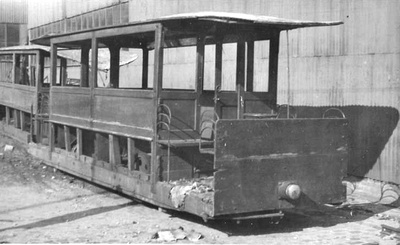
 Corporation take over
Corporation take over
In 1938, Brighton Corporation took control of the VER, initially leasing the line and operation back to Herman Volk, however, they assumed complete control on 1st April 1940. Unfortunately by this time Britain was at War and under the serious threat of Nazi invasion. By July 1940, the railway had closed for the duration, with the cars being transfered to Lewes Road tram / bus depot for storage and the stations at Aquarium and Black Rock being demolished. Later in the war, the depot was required for other purposes and the cars were moved out into secure open storage under the arches at Maderia Drive, with the outdoor storage causing irrepairable damage to cars 1, 2 and 5 which had to be scrapped.
Reopening
After the war, the line needed some serious work to get it operational again, Black Rock station was rebuilt again in the same art deco style as pre war, whilst a former tram shelter became the new station building at Aquarium. The full track was relaid as was the third rail. Replacement cars were sought for the scrapped cars and these came in the shape of 2 ex Southend Pier rail trailers, which seated 40 people and were converted to motor vehicles. They were fitted with ex milk float motors and became the fastest cars in the fleet!
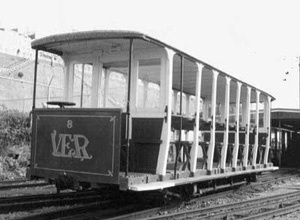
 A renumbering of the fleet occured to fill up the numbers left vacant by the scrapped cars with no 10 becoming no 1, no 9 becoming no 2 and no 8 becoming no 5 with the ex Southend cars becoming 8 & 9.
A renumbering of the fleet occured to fill up the numbers left vacant by the scrapped cars with no 10 becoming no 1, no 9 becoming no 2 and no 8 becoming no 5 with the ex Southend cars becoming 8 & 9.
The line reopened on 15th May 1948 and from Winter 1954 became seasonal only.
In 1964, a successful experiment with the coupling of 2 cars together was successful and all cars were converted to allow them to be coupled, meaning less staff and less individual cars could be used, ultimately saving money and allowing for track rationalisation at both termini with only one platform and track required.
Moving on towards the 1990s and the 1948 built station at Black Rock was demolished and a new station was incorporated into the building of a new pump house built next to the station for a storm drain project.
New Millennium
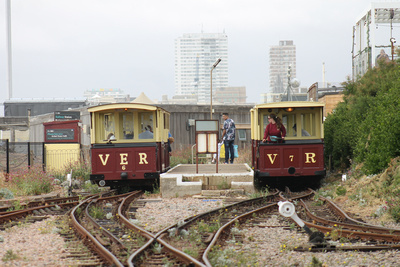
 Into the 2000s and the ex Southend cars were withdrawn as surplus and moved on with no 8 going back to Southend and being displayed in a glass box at the pier museum and no 9 going to the South Downs Heritage Centre. Cars 1, 2 and 5 then reverted back to their pre 1948 numbers of 10, 9 and 8.
Into the 2000s and the ex Southend cars were withdrawn as surplus and moved on with no 8 going back to Southend and being displayed in a glass box at the pier museum and no 9 going to the South Downs Heritage Centre. Cars 1, 2 and 5 then reverted back to their pre 1948 numbers of 10, 9 and 8.
After receiving Heritage Lottery funding in 2015, work was started on a major upgrade of the facilities on the line, which was badly needed as the car sheds had been condemned. The carsheds were completely flattened and rebuilt, with the Tunnel being retained through the car shed! Meanwhile the station building at Aquarium was also demolished and rebuilt, complete with a small visitor centre, ticket office and takeaway cafe built in. The car fleet also received some work with major restoration / rebuilt works being carried out on cars 4, 6 and 10. With car 3 also in the midst of a rebuilt, the future of the VER is looking good!
Fleet List
|
Original Fleet Number |
Fleet Number (1948-2000) |
Current Fleet Number |
Car Type |
Year Built |
Seating Capacity |
Built By |
Current Status |
Notes |
Photo |
|
1 (I) |
N/A |
N/A |
Open |
1883 |
10 |
William Pollard |
scrapped |
Original car from the original demonstration line, could not be regauged from 2ft - 2ft 8 1/2 inches, scrapped 1884 |
|
|
1(II) |
N/A |
N/A |
Semi-Open |
1884 |
30 |
Unknown |
scrapped |
suffered the effects of outside storage for a long period during wartime, was too far gone for repair and scrapped in 1948 |
|
|
2 |
N/A |
N/A |
Semi-Open |
1885 |
30 |
Unknown |
scrapped |
suffered the effects of outside storage for a long period during wartime, was too far gone for repair and scrapped in 1948 |
|
|
3 |
3 |
3 |
Semi-Open |
1892 |
40 |
VER |
undergoing restoration |
Currently stripped awaiting restoration |
|
|
4 |
4 |
4 |
Semi-Open |
1892 |
40 |
VER |
in service |
received a major restoration between 2016-2018 |
|
|
5 (I) |
N/A |
N/A |
Semi-Open |
1896 |
30 |
VER |
scrapped |
Was in need of a major rebuild in late 1920s, was scrapped instead and replaced by 2nd no 5 |
|
|
5 (II) |
N/A |
N/A |
Closed |
1930 |
24 |
G Kelsey / VER |
scrapped |
Winter car, only car in fleet to have fully enclosed passenger saloons. Suffered the effects of outside storage for a long period during wartime, was too far gone for repair and scrapped in 1948 |
|
|
6 |
6 |
6 |
Semi-Open |
1901 |
40 |
VER |
in servce |
Received a major restoration 2016-2018, works as a pair with Car 10 |
|
|
7 |
7 |
7 |
Semi-Open |
1901 |
40 |
VER |
in service |
Works as a pair with car 8 |
|
|
8 (I) |
5 |
8 |
Semi-Open |
1901 |
40 |
VER |
in service |
Was numbered 5 between 1948 and 2000, works as a pair with car 7 |
|
|
8 (II) |
8 |
N/A |
Open |
1898 |
40 |
Falcon Works |
preserved |
Operational on VER from 1948 - late 1990s, now a static exhibit at Southend Pier Tramway |
|
|
9 (I) |
2 |
9 |
Open |
1926 |
40 |
VER |
in service |
Was numbered 2 between 1948 and 2000, works as a single car only |
|
|
9 (II) |
9 |
N/A |
Open |
1898 |
40 |
Falcon Works |
preserved |
Operational on VER from 1948 - late 1990s, now a static exhibit at South Downs Heritage Centre |
|
|
10 |
1 |
10 |
Open |
1926 |
40 |
VER |
in service |
Was numbered 1 between 1948 and 2000, works as a pair with car 6 |
.
Trip Report
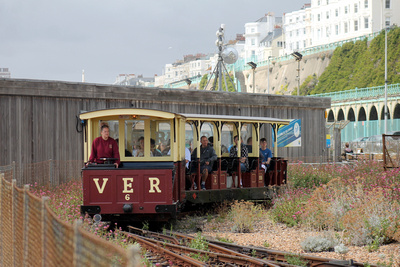
 I visited the VER on 25th July 2022 whilst on a daytrip to Brighton. Having only intended to visit for a very short time, I actually ended up spending longer than I expected on the railway (about 3 hours!).
I visited the VER on 25th July 2022 whilst on a daytrip to Brighton. Having only intended to visit for a very short time, I actually ended up spending longer than I expected on the railway (about 3 hours!).
Having never been in Brighton before, I decided to catch the City Sightseeing bus round to get my bearings, it was an interesting experience, especially losing my baseball cap, which blew off on the top deck and was squashed by a passing car!
I arrived at the Aquarium station, which is a couple of minutes walk from the Palace Pier and the City Sightseeing bus stop and bought my ticket then had a look round the visitor centre at the interesting displays and artifacts from the history of the line while I waited for the train to arrive. I didn't have long to wait as the trains run every 15 minutes as 1901 built Semi Open Cars 8 + 7 soon arrived and I boarded the open section of car 8, which would be the rear portion of the train for the mile long journey to Black Rock. We soon departed at a leisurely pace heading to Halfway, where we would await the arrival of the other train in service, made up of 1926 built open car 10 and 1901 semi open car 6 to allow the drivers to swap tokens for each stretch of single line. We continued our journey, passing through the tunnel, where car 4 and some permanent way vehicles were visible on the right hand side of the shed. All too soon we reached the terminus at Black Rock, where we all had to leave the train and reboard it although the driver was kind enough to let me take some photos of the train before I left the platform.
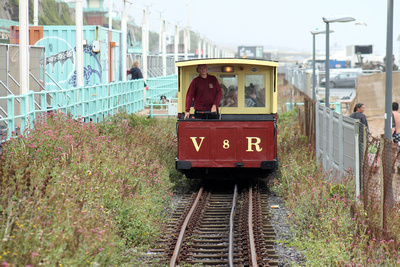
 I then joined the queue to reboard and this time I sat in the open section of car 7. On arrival at Halfway, I got off to take some photographs of the trains before heading to the workshop gallery to view the depot. Unfortunately the viewing gallery was closed, however I managed to photograph 1926 built Open Car 9 and a pw trailer, which were stabled in the left hand side of the depot from the station platform. Also out on the lineside at Halfway were some old wheels on axles and an old wooden underframe, which I assume was from Car 3 as it is currently undergoing an overhaul.
I then joined the queue to reboard and this time I sat in the open section of car 7. On arrival at Halfway, I got off to take some photographs of the trains before heading to the workshop gallery to view the depot. Unfortunately the viewing gallery was closed, however I managed to photograph 1926 built Open Car 9 and a pw trailer, which were stabled in the left hand side of the depot from the station platform. Also out on the lineside at Halfway were some old wheels on axles and an old wooden underframe, which I assume was from Car 3 as it is currently undergoing an overhaul.
After taking some more photographs from different locations around Halfway station, I caught Open Car 10+Semi Open Car 6 back to Aquarium, and I decided to take some more photos around that area, when the heavens opened and there was a heavy shower! After getting a few photographs, I made my way back into Brighton to catch the tour bus.
I'd like to thank the Volk's Electric Railway Association for allowing me to use some of their archive photographs in this post. My photos from the trip can be found at: https://scottishtrains.zenfolio.com/p588123192
I would definatley recommend a visit, the price of £5.60 for adults and £3.50 return for children is worth the money, the cars are all well kept and the staff are extremely friendly and helpful and will answer any questions that you have! To find out more about the Volk's Electric Railway (VER) and the Volk's Electric Railway Association (VERA), please visit their websites: https://volksrailway.org.uk/ VER: VERA: http://volkselectricrailway.co.uk/
Blackpool Jubilee Heritage Tram Parade 2.6.22
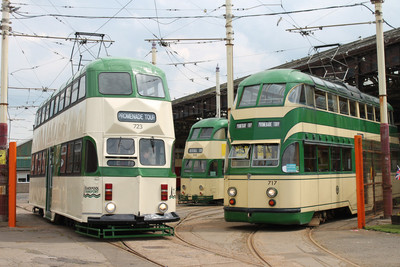
 On Thursday 2nd June, I headed down to Blackpool for the day to see the Jubilee Heritage Tram Parade.
On Thursday 2nd June, I headed down to Blackpool for the day to see the Jubilee Heritage Tram Parade.
I arrived in Blackpool around 11.30am and it was already very busy and my usual car park of choice at Pleasure Beach was already full, however I managed to get parked outside the Solaris Centre at Harrowside. I walked up the prom to Manchester Square and round to Rigby Road depot where the trams for the parade were beginning to be shunted round and sorted into order before heading out to the Prom and down to Pleasure Beach for the parade.
The first tram out was red and cream liveried Boat car 227, which was to lead the parade, it was stabled on Hopton road, whilst Balloon 723 was shunted down to the far end of the depot fan and 717 was shunted onto the Electrical compound track to release Boat 600 to move off depot to be stabled on Hopton Road behind Boat 600. Next out was Brush Car 631, which was moved out onto Hopton Road and parked up behind 227 and 600. The fourth tram to leave depot was a nice surprise in 90s Green and Cream liveried Ex Towing Railcoach 680, which was making its first appearance since March 2020 (pre lockdown).
After the trams were checked over by their crews, 227 and 600 departed Hopton Road, turned on to Lytham Road and onto the prom. After being reversed at Foxhall, they made their way to Pleasure Beach for the parade. Once 227 and 600 were clear of Lytham Road, 631 and 680 followed suit.
Next the Frigate 'HMS Blackpool' 736 was brought out on to Hopton Road to reverse onto Blundell Street where it stabled alongside the Fitting Shop wall. Balloon 723, freshly out the Paint Shop in the modernised balloon version of the 90s Green and Cream with black window surrounds, was then shunted out onto Hopton Road and then shunted back into one of the depot roads to release Fisherman's Friend trawler 737. 737 was also shunted out onto Hopton Road and reversed onto Blundell Street in front of 736. 80s Green and Cream liveried Centenary car 648 was then brought out and headed straight to the prom to take up position 5 in the parade. 648 was followed by the Western Train (733+734), which came out with the carriage leading so that it was facing the correct way once it changed ends at Foxhall.
Once the Western Train was clear of Hopton Road, the trawler (737) was turned on the triangle so it was heading out in reverse, with 736 completing the same move with both trams then departing towards the prom. One final shunt move saw Balloon 717 moved off the electrical compound track and onto Hopton Road before being moved further back the depot fan to release Bolton 66. Balloon 717 would then be the next tram to depart towards the prom followed by Balloon 723, Balloon 700 and Millenium Balloon 707.
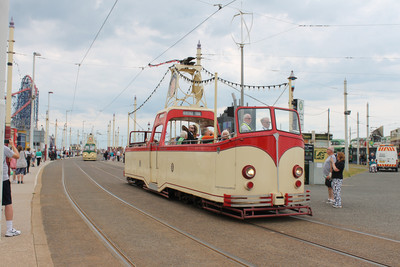
 I then walked down to Pleasure Beach where the loop was choc-a-block with heritage trams, passengers, sightseers and enthusiasts! After a few photos on the loop, I took up position near the entrance to the loop and photoed the parade, which featured 13 trams. These were:
I then walked down to Pleasure Beach where the loop was choc-a-block with heritage trams, passengers, sightseers and enthusiasts! After a few photos on the loop, I took up position near the entrance to the loop and photoed the parade, which featured 13 trams. These were:
- Boat 227
- Boat 600
- Brush Car 631
- Ex Towing Railcoach 680
- Centenary 648
- The Western Train (733+734)
- Fisherman's Friend Trawler (737)
- Frigate 'HMS Blackpool' (736)
- Bolton 66
- Balloon 717
- Balloon 723
- Balloon 700
- Millennium Balloon 707
Once the parade departed, I walked up towards Manchester Square to see the trams returning, with all bar Boat 227, Boat 600, Bolton 66 and Balloon 717 returning to depot. Rather than running straight in, The Western Train ran to Pleasure Beach and back to Foxhall where it reversed in.
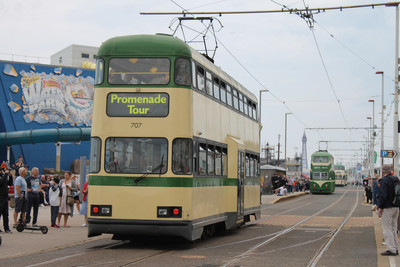
 Boat 227, Boat 600, Bolton 66 and Balloon 717 operated a Heritage service between Pleasure Beach and Bispham between 4pm and 7pm, however Boat 600 failed at Bispham and was replaced by Balloon 723. After 7pm, the Western Train operated two evening tours between Pleasure Beach and Little Bispham to round off an excellent day.
Boat 227, Boat 600, Bolton 66 and Balloon 717 operated a Heritage service between Pleasure Beach and Bispham between 4pm and 7pm, however Boat 600 failed at Bispham and was replaced by Balloon 723. After 7pm, the Western Train operated two evening tours between Pleasure Beach and Little Bispham to round off an excellent day.
Well done to everyone at Blackpool Transport, Heritage Tram Tours and Tramtown for organising such an excellent event!
More photos from the day can be found at: https://scottishtrains.zenfolio.com/p50243848
Blackpool Tramway Heritage Weekend and Depot tour 30.4.22
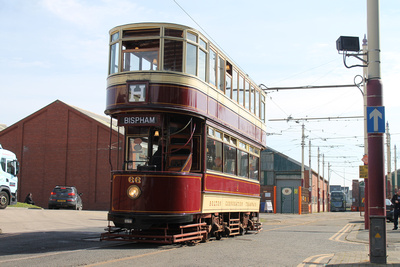
 Over the Bank Holiday weekend of 30th April - 2nd May, Blackpool Heritage Tram Tours held a Vintage Weekend with Heritage trams running along the prom every 15 minutes and hourly to Fleetwood. As well as the trams, there was vintage bus rides to Fleetwood and to Lytham St Annes!
Over the Bank Holiday weekend of 30th April - 2nd May, Blackpool Heritage Tram Tours held a Vintage Weekend with Heritage trams running along the prom every 15 minutes and hourly to Fleetwood. As well as the trams, there was vintage bus rides to Fleetwood and to Lytham St Annes!
I visited on Saturday 30th April and after a reasonably quiet journey down the M74, M6 and M55, I arrived at Blackpool and parked up at Pleasure Beach at 9.30am, in the reasonably warm sunshine! I walked from Pleasure Beach up to Manchester Square then round to Rigby Road depot to see the heritage trams coming off depot and going into service.
Heritage trams in Service were Route A: 631, B: Boat 600 (in place of the advertised Boat 227), C: Illuminated Frigate 736, D: Centenary 648, E: Balloon 715 and F: Bolton 66. Also out was Balloon 717 on a private hire.
At 10.30am I joined the first of two Tramtown tours of the day and as it was a good deal drier and sunnier than my last time on the tour in February when it snowed! The tour began outside in the yard where after the safety briefing, we walked along the side of the workshops past the depot fan and round to the Paint Shop.
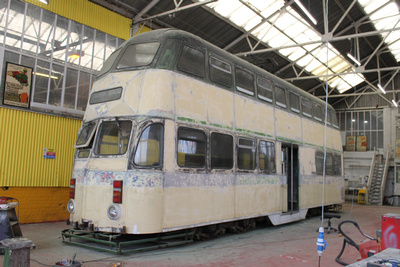
 In the paint shop was Balloon 723, which has been stripped of it's Christmas vynals and had the 80s livery that was underneath the vynals sanded down ready for a repaint into an as yet undisclosed livery. It was interesting to hear that the trams are still hand painted using brushes rather than being spray painted as the brushed on paint gives a thicker coat that lasts longer in the harsh salt and sand ladened environment of Blackpool. We also heard how there is now only one painter, who deals with all the heritage tram fleet as well as touching up bus panels as well, the painter does a fantastic job with some stunning paint jobs on display on the heritage fleet!
In the paint shop was Balloon 723, which has been stripped of it's Christmas vynals and had the 80s livery that was underneath the vynals sanded down ready for a repaint into an as yet undisclosed livery. It was interesting to hear that the trams are still hand painted using brushes rather than being spray painted as the brushed on paint gives a thicker coat that lasts longer in the harsh salt and sand ladened environment of Blackpool. We also heard how there is now only one painter, who deals with all the heritage tram fleet as well as touching up bus panels as well, the painter does a fantastic job with some stunning paint jobs on display on the heritage fleet!
The tour then moved into the Body Shop where Brush Car 634 in its new Terror Tram advert was stabled awaiting attention prior to a potential entry into service later this year, also there were the bodies of Lytham 31 and Glasgow 1016, both of which are future major restoration projects. It was interesting to hear how both trams came to be snapped up by Heritage Tram Tours and the future plans for both trams. One current major restoration project on the tramway is that of Balloon 704. 704 has been stripped to its basic framework awaiting the fitting of a new underframe as it's current one is life expired and drooping at the ends. Once some repair work has been done on the current body frame, 704's frame will be transferred onto a new underframe that we will see in the next part of the tour, the fitting shop.
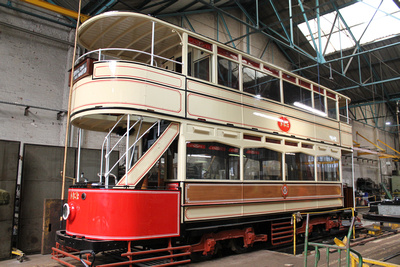
 In the fitting shop, we see the large array of blacksmiths tools and the forge that alot of spare parts are made in. Due to the age of the fleet, parts are not available off the shelf so have to be made. One item that has been made recently from scratch is a complete replacement underframe, which will go under Balloon 704. The underframe for 704 which was built by one engineer working from a set of plans initially drawn up 90 years ago and found in the heritage archives. Again, this highlights the 'can do' attitude of the staff and volunteers at Heritage Tram Tours, Tram Town and Blackpool Transport.
In the fitting shop, we see the large array of blacksmiths tools and the forge that alot of spare parts are made in. Due to the age of the fleet, parts are not available off the shelf so have to be made. One item that has been made recently from scratch is a complete replacement underframe, which will go under Balloon 704. The underframe for 704 which was built by one engineer working from a set of plans initially drawn up 90 years ago and found in the heritage archives. Again, this highlights the 'can do' attitude of the staff and volunteers at Heritage Tram Tours, Tram Town and Blackpool Transport.
Also in the Fitting Shop was Standard 143. Standard 143 was transferred to the Fylde Transport Trust in 2003 to restore from a fire damaged works tram back to its original condition as a 1924 built Standard Car. As it was discovered that there was an issue with one of 143s motors following restoration, the motors from Standard 147 have been transferred to 143 to allow the tram to enter service hopefully by the summer and 147 will also be back in service once the repaired motors have returned from the company who are repairing them.
Another feature of the Fitting shop that we got to see was the gas ring that is used to remove old tyres from the tram wheels and for the fitting of new tyres.
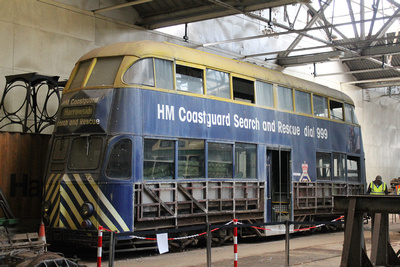
 We then crossed over to the main depot building, where it is safe to say that the roof is in a sorry state and full of holes. Part of the reason for Tramtown being set up and the tours running is to help to raise some of the money required to replace the roof and to allow the tram fleet to be in a far more protected environment which will protect the heritage fleet from the elements. Future plans also include the current engineering facilities in the workshops being moved over into the main depot as well as the building being used as a visitor centre for the tramway, however not of the 'stuffed and mounted' variety where every tram in it becomes a non runner. Tramtown want the trams to be running out on the prom and also eventually to bring visitors to Tramtown by tram!
We then crossed over to the main depot building, where it is safe to say that the roof is in a sorry state and full of holes. Part of the reason for Tramtown being set up and the tours running is to help to raise some of the money required to replace the roof and to allow the tram fleet to be in a far more protected environment which will protect the heritage fleet from the elements. Future plans also include the current engineering facilities in the workshops being moved over into the main depot as well as the building being used as a visitor centre for the tramway, however not of the 'stuffed and mounted' variety where every tram in it becomes a non runner. Tramtown want the trams to be running out on the prom and also eventually to bring visitors to Tramtown by tram!
One thing you'll notice when you visit Tramtown is that there are always improvements from your last visit! In the space of 2 months, some new viewpoints have opened up within the sheds allowing you to get closer to and photograph more of the fleet, various parts of the depot have received a new coat of paint including the track numbers having been repainted on the ground on the depot fan. Last time we got to sit onboard Bolton 66, this time we got to sit on board Coronation 660 and found out some of the interesting history of the fleet of 25 Coronation trams that were meant to revolutionise the tramway in the 1950s but had a short working life and were mostly scrapped by the 1970s.
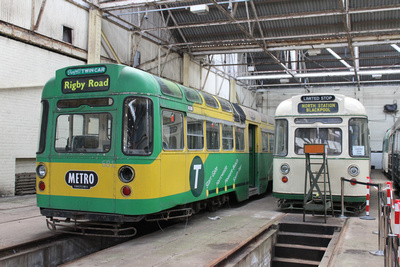
 We were then taken to the first of the new viewing areas opened up where we heard some of the history of the illuminated fleet in front of the long stored Hovertram 735. The viewing area also gave the chance for a close look at Brush cars 625 and 632 as well as Twin Car trailers 681 and T2.
We were then taken to the first of the new viewing areas opened up where we heard some of the history of the illuminated fleet in front of the long stored Hovertram 735. The viewing area also gave the chance for a close look at Brush cars 625 and 632 as well as Twin Car trailers 681 and T2.
The next new viewing area gave a view of Princess Alice - Open topped Balloon 706, which is awaiting a new underframe and the long stored 'Tramnik 1' the Rocket tram 732. The final stop of the visit was to the Electrical Compound to see the Western Train and a visit to the shop, where I purchased a TramTown planter for my garden!
Before I left Tram Town, I asked our helpful guide if I could get a couple of photos of Balloons 700 and 703 and Railcoach 279, which is nearing completion of its restoration back to a series 2 EE Railcoach.
I would definately recommend a visit to TramTown for not just enthusiasts, but anyone who is interested in history! Tramtown run tours of the depot every Saturday and Monday both as a depot tour (approx. 1 hr 30 mins) or as a family tour (approx. 45 mins). Available dates and times can be found on their website: https://blackpoolheritage.com/guided-depot-tours/
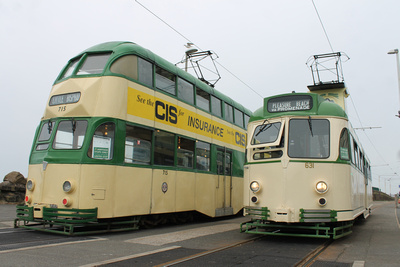
 After the tour, I made my way back to the prom and caught Centenary tram 648 to Pleasure Beach (to put my new planter in the car!). I then caught Bolton 66 to Bispham, where I got off to take some photos! Next I caught Balloon 715 to Little Bispham and back before switching to Boat 600 for a rather breezy run to Thornton Gate and back to Bispham! I then caught Centenary 648 to Little Bispham then back down to Pleasure Beach, where I took some more photos then headed home!
After the tour, I made my way back to the prom and caught Centenary tram 648 to Pleasure Beach (to put my new planter in the car!). I then caught Bolton 66 to Bispham, where I got off to take some photos! Next I caught Balloon 715 to Little Bispham and back before switching to Boat 600 for a rather breezy run to Thornton Gate and back to Bispham! I then caught Centenary 648 to Little Bispham then back down to Pleasure Beach, where I took some more photos then headed home!
More Photos from my trip can be found at: https://scottishtrains.zenfolio.com/p820301502
